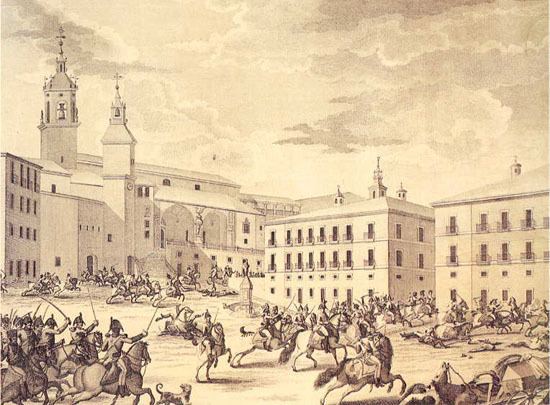 | ||
The Second tower of the Plaza de la Virgen Blanca, also called Tower of the Correría was the smaller of the two towers that noted for its height, the other (the higher) tower exist today intact, that were in the Plaza de la Virgen Blanca, in Vitoria-Gasteiz (Basque Country autonomous community, Spain).
Contents
This arose first as a City gate, then had a reform in 1650 that changed it as a belfry but remaining the gateway, and all part of its structure, adding the top half of the tower, being an element of the walls, on this side of the city, while existed this building.
It belonged, as the rest of the portals to different families, to its respective civilian Vitorian family.
The Portal and its tower were demolished in the second half of the 19th century.
Description
Before 1650 this building was a city gate with a Gothic arc, after the 1650 reform had semicircular arches.
It had a reform in 1650 by four stonemasons who worked, who were; José and Simón de Ontanilla, Alejandro del Camino and Domingo de Loyo.
Micaela Portilla in the second volume of her well-known work "Towers and fort houses in Álava" (pages 1070 and 1071) said the following about this tower:
When Friar Juan de Vitoria refers to the gates of the city in the Middle Ages and the families who defended it expressly cited as 'fort houses' those of the Portal de la Correría owned by the Nanclares. Says, in effect, Friar Juan de Vitoria the Portal and fort houses either sides of the Correría were of the Nanclares, related to the Sotos which had in turn entrances of the Zapatería.
According the reference, it can be surmised that the inhabitants of the tower of the Correría were actually members of the lineage of the Nanclares. That is almost certainly to the 15th century (considering that Friar Juan de Vitoria is a chronicler of the 16th century, who wrote much of the Vitoria that he knew in his youth,
According Venancio del Val in his well-known work 'Streets of Vitoria' on page 11 of the 1979 edition:
When beginning the second half of the 19th century was the entrance arch to this street the first one, that for hygiene reasons, was shot down. Until then it penetrated under an arch on which a turret rising, in which we believe was the first public clock in the city (this clock is now located in the other surviving tower). It also seems that once stood in that arch the image of St. George, if we pay attention to what Becerro de Bengoa wrote late last century (19th c.).
In 'La Libertad' newspaper of 26 January 1898, it found the entry where Becerro de Bengoa said:
The old Vitoria, where we lived most of Vitorians of the first half of this century is disappearing some of its most precious remains and memories. With deep sorrow i have seen demolish the house of D. Francés de Beaumont", then follow the text with a list of destroyed buildings until the "arch and tower of the clock with the image of Saint George, of the Correría".
Remains
The San Miguel clock is now a distinctive element of the bell tower of the Church of San Miguel, this bell tower is seen in the foreground in the square. Now, originally this clock was not in the tower. It was in this neighboring tower, crowning the structure of the Portal of the Correría Street.
